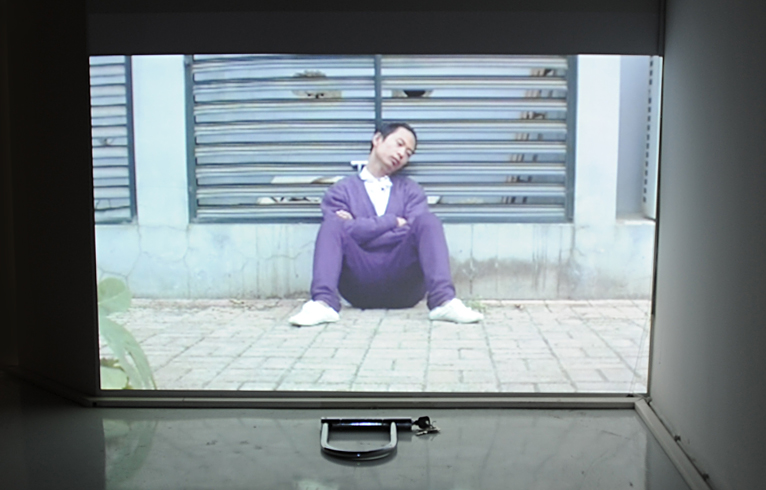THE THINGS THEY ARE A-CHANGING
| March 26, 2012 | Post In LEAP 13

Outside an upscale shopping district in the center of Wuhan, following a graffiti-covered wall around an inconspicuous corner, one may find the entrance to Chi K11 Art Space. The small elevator, with only enough elbow room for two people, does not hold a single clue to indicate that there might be an art space upstairs, save for two exhibition posters on its walls. Arriving at the gallery, the door was open and there were no visitors or employees to be found; it was like having unwittingly burst into a vacant warehouse. Just as the exhibition title suggests, “the things they are a-changing.” Obviously, our understanding of reality, space, consumption, surveillance, and the public and the private have begun to change as well, and this is the very issue that the three young artists of this exhibition are attempting to put forth through their own daily practices.
In his foreword, curator Gong Jian proposes a relationship between subject and object that is in the midst of change. Whether it be through “unpretentiously objecting to the [criticized] object” or “eliminating the boundary between the subject and the object,” he uniformly emphasizes the subjectivity of these artists and their desire to transform objects. In his works Spring Breeze and Single Bed, the artist Li Liao directly objectifies himself; locking himself outside an office building all day and falling asleep in public spaces, he offers his own body up to the surveillance and suppression of modern society. These are actions that can be observed and gradually yet completely deprived of their subjective vulnerability. As presented in the exhibition, the “minor gesture” shown by the filming of these actions is indeed far removed from the radicalism that they originally bore. We should never forget that art’s radical nature is built upon imagination— not upon viewer participation and spectatorship— but the artist nonetheless employs these most common of actions to expose the absurd position of the individual within the particular order of society.
Compared to Li Liao’s micro-politics, the works of the young artist Hu Qingtai both reference and echo conceptual art. His 30°33’08.95”N, 114°18’26.52”E, 13:41-15:28 is reminiscent of Bruce Nauman’s Mapping the Studio, only this time the site is outdoors, and the result of Hu’s survey ultimately takes on sculptural form. The sheer frustration and difficulty of repeating, remembering, or writing down the work’s title, even, seems to suggest that the title directly rejects the possibility of its own transmission. The Ball and The Filings of Wood and Tightly Stretched Canvas appear to come from the same series, while a closer look reveals that Tightly Stretched Canvas is in fact not only a re-telling of a process, but the declaration of a painting none of us has ever seen, thereby “changing things”: “on December 7, 2011, I gave it [the painting] to the doctor, half a month before surgery.”
For his Dream Meal Plan. Wei Yuan cooked and provided 80 squid-filled fried dough sticks to exhibition visitors on-site, part of his “human food,” in which Wei “recruits” food-related dreams from society and publishes them in booklets. If there is any practical significance to these flights of fancy, it is the fun and imagination that accompany the acting out of delusions, like bringing a character from a Haruki Murakami novel to life. Just as Stephen Johnstone wrote in The Everyday, ever since the “everyday” entered the field of contemporary artistic practice, the majority of works have revealed one thing: “Art has commemorated ordinary dignity, celebrated the accidentally miraculous… and mediated what happens when nothing happens. An engagement with ordinary life also has a political dimension, offering a voice to the silenced and proposing possibilities for change.” Nikita Yingqian Cai (Translated by Katy Pinke)

